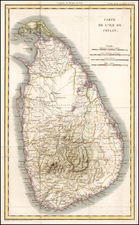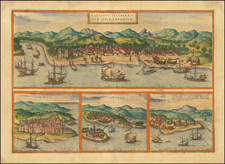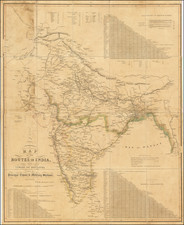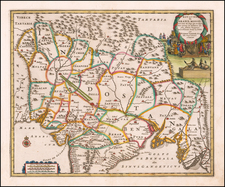Published in Calcutta -- An Extraordinary Rarity
Remarkable large map of the Awadh (northeastern portion of Uttar Pradesh).
Drawn from the Great Survey of India, the map is exceptionally detailed showing over 1000 settlements along with roads, rivers and other geographical features.
Oudh, also known as Awadh, played a significant role in the 19th-century history of India, characterized by its rich culture, political upheavals, and eventual annexation by the British Empire.
In the early 19th century, Oudh was a princely state in the Mughal Empire, with its capital at Lucknow. The city of Lucknow, along with other major cities like Faizabad, was a center of music, poetry, and traditional crafts, contributing to a vibrant cultural milieu.
The governance of Oudh during this period was under the Nawabs, who were initially semi-autonomous rulers under the Mughal Empire. However, with the decline of Mughal power, the Nawabs of Oudh gradually gained more independence. The most notable Nawab in the early 19th century was Nawab Saadat Ali Khan II, under whose rule Oudh saw considerable development in arts and architecture.
The geopolitical landscape of Oudh in the 19th century was significantly influenced by the British East India Company, which sought to expand its control over India. The Treaty of Lucknow in 1801 marked a turning point, wherein Nawab Saadat Ali Khan II ceded half of his territories to the British and agreed to disband his army in exchange for a subsidy. This treaty significantly reduced Oudh's sovereignty, making it a client state of the British.
As the century progressed, the British continued to exert more control over Oudh, often citing misgovernance by the Nawabs as a pretext. The annexation of Oudh in 1856 by Lord Dalhousie, the then Governor-General of India, was a controversial move that disregarded the treaty agreements. Dalhousie implemented the Doctrine of Lapse, claiming that the Nawab of Oudh was incapable of managing the state, and officially incorporated Oudh into the British Empire.
The annexation of Oudh played a pivotal role in the Indian Rebellion of 1857. Discontent among the people of Oudh, along with the disbandment of the Oudh army, fueled the uprising. The rebellion saw widespread participation from all sections of society in Oudh, including peasants, nobles, and dispossessed soldiers. The city of Lucknow witnessed one of the most prolonged sieges during the rebellion, becoming a symbol of resistance against British rule.
After the suppression of the rebellion, the British Raj implemented direct rule over Oudh, marking the end of the Nawabi era. The aftermath of the rebellion also led to significant changes in British governance policies in India.
Rarity
The map is extremely rare. OCLC locates a single example at the University of Aberdeen.











![[ Postal Map of India ] India Shewing The Post Roads And Dawk Stations By James Wyld . . .](https://storage.googleapis.com/raremaps/img/small/99685.jpg)


![Northern Hindostan [with] Nepaul [with] Cabul](https://storage.googleapis.com/raremaps/img/small/62805.jpg)

